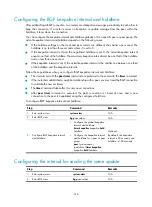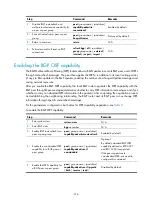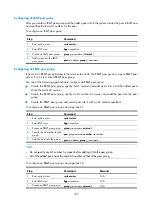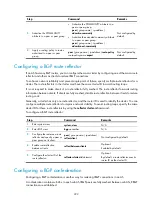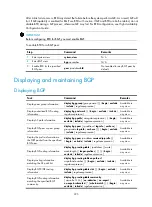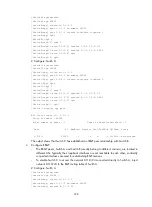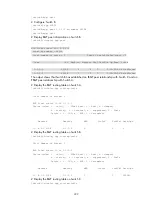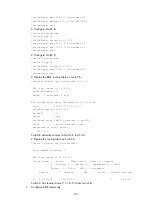
223
If routers not compliant with RFC 3065 exist in the confederation, use the
confederation nonstandard
command to make the local router compatible with these routers.
Configuring a BGP confederation
After you split an AS into multiple sub ASs, you can configure a router in a sub AS as follows:
1.
Enable BGP and specify the AS number of the router.
2.
Specify the confederation ID. From an outsider’s perspective, the sub ASs of the confederation is
a single AS, which is identified by the confederation ID.
3.
If the router must establish EBGP connections to other sub ASs, you must specify the peering sub
ASs in the confederation.
A confederation contains a maximum of 32 sub ASs. The AS number of a sub AS is effective only in the
confederation.
To configure a BGP confederation:
Step Command
Remarks
1.
Enter system view.
system-view
N/A
2.
Enter BGP view.
bgp
as-number
N/A
3.
Configure a confederation ID.
confederation id
as-number
Not configured by
default.
4.
Specify peering sub ASs in the
confederation.
confederation peer-as
as-number-list
Not configured by
default.
Configuring confederation compatibility
If some other routers in the confederation do not comply with RFC 3065, enable confederation
compatibility to allow the router to work with those routers.
To configure confederation compatibility:
Step Command
Remarks
1.
Enter system view.
system-view
N/A
2.
Enter BGP view.
bgp
as-number
N/A
3.
Enable compatibility with routers not
compliant with RFC 3065 in the
confederation.
confederation nonstandard
Optional.
Not enabled by default.
Configuring BGP GR
Perform the following configuration on the GR Restarter and GR Helper.
Follow these guidelines when you configure BGP GR:
•
A device can act as a GR Restarter and GR Helper at the same time.
•
The maximum time allowed for the peer (the GR restarter) to reestablish a BGP session must be less
than the Holdtime carried in the Open message.
•
The End-Of-RIB (End of Routing-Information-Base) indicates the end of route updates.
To configure BGP GR:






